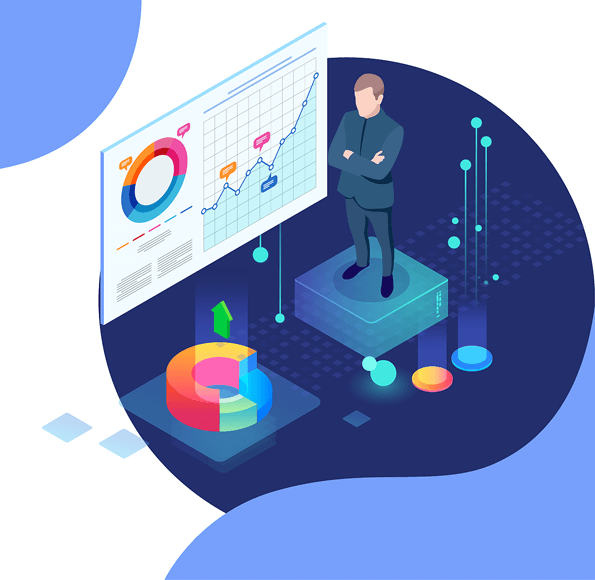The Role of Statistics in Data Analytics: Training for Effective Analysis

Strong 8k brings an ultra-HD IPTV experience to your living room and your pocket.
Discover how statistics are used in data analytics and how they help with classification, prediction, and the development of learning algorithms, among other things. Find out about the several courses that offer practical instruction in the use of statistics in data science and data analytics. Classes are offered both live online and in person in New York City.
In the mathematical field of statistics, data is analyzed and modified to represent particular properties. Both quantitative and qualitative data might be employed. Users can gather, examine, and analyze data using statistics. They can also use statistics to draw conclusions from the data and eventually improve business decisions.
In addition to being a distinct field of mathematics, statistics is crucial to the data analytics process. The process of applying statistical approaches to data analytics is essential since it facilitates new discoveries, informs decision-making, and aids in future prediction.
This essay will examine the many advantages statistics offers data workers today, as well as how statistics has traditionally been employed in data analytics.
An Overview of the Use of Statistics in Data Analytics Throughout History
Over the last 350 years, statistics has been a crucial component of the data analytics sector. John Graunt finished the first statistical data analysis experiment in London in 1663. Graunt recorded death data and postulated the development of a warning system to facilitate the early identification of the Plague. Richard Millar Devens first used the term "business intelligence" in 1865, more than two centuries later. The Hollerith Tabulating Machine was then created in 1880. It made it easier to process the ten-year backlog of data that needed to be processed by the US Census Bureau. This machine shortened ten years of number crunching into a few months by using punch cards.
What is the Current Data Analytics Use of Statistics?
Data science and data analytics continue to rely heavily on statistics. Among the several ways this area of mathematics is assisting data analysts in handling large amounts of data are the following:
Testing hypotheses is an important part of the analytics process. A hypothesis test is intended to assess two statements about a certain population that are mutually exclusive. This test is a useful instrument for determining the statistical significance of a result.
Estimation and probability distribution creation are facilitated by the application of statistical techniques to data, and these processes can lead to a deeper comprehension of logistic regressions and machine learning.
Business intelligence is informed by statistics: Statistics is frequently employed in a variety of business operations to give outcomes a degree of confidence that may subsequently be utilized for projections and forecasts.
Developing learning algorithms: To satisfy the demands of data analysis, algorithms like logistic regression and naive Bayes have developed.
Supporting classification and prediction: Statistics is an effective tool for classifying and predicting data.
Using descriptive statistics: Using descriptive statistics makes it possible to deliver the insights in an understandable way to a non-technical audience by providing descriptions and summaries of the data together with visualization possibilities.
Calculating probability: Probability-related statistical formulas have a wide range of applications. A few instances are actuarial charts, therapeutic studies, political polling, and even estimating the likelihood that a population may contract a disease.
The Advantages of Data Analytics with Statistics
Statistics serve as a basis for working with data analytics and data science, providing fundamental ideas and building blocks that must be grasped before a data analyst can work with more sophisticated algorithms. Furthermore, metrics like median, mean, and variance, as well as trends and outliers, can be easily identified with the use of visual representations of data.
The use of statistics in data analysis has several advantages, including:
It offers a method for categorizing and arranging data. Users can arrange and classify data through classification to create precise and visible analytics. For companies who will incorporate these insights into their business plans, this is a crucial first step.
Data can be structured using statistics. An organization can find trends and anomalies in a large amount of data by using statistical analysis. Instead of squandering time and money later on, the organization may simply eliminate any unnecessary data right away.
It offers significant perceptions into how businesses operate.
Processing data is aided by statistics.
It can be applied to identify data clusters and other structures that are dependent on time or space.
It is possible to compute probability distribution using statistical methods.
It makes graphs and networks usable for statistical modeling.
Data visualization heavily relies on statistics. In data analytics, graphic representations of data give numbers a visual form so that patterns and trends in quantitative data can be seen.
The same graphs, pie charts, and histograms that are used in statistics are also used in these representations. It is simpler to identify errors or trends when data is presented in an engaging and comprehensible way like this in these visualizations.
Testing of Hypotheses
One statistical technique for assessing results and determining their significance is hypothesis testing. By comparing a hypothesis with data, data analytics is an essential methodology that enables professionals to make well-informed decisions. Essentially, it's a means of ascertaining whether data-driven insights are the result of chance or have a known cause.
Hypothesis testing, for instance, can be used to assess the performance of a marketing effort by examining consumer behavior. Data experts can decide what kind of ads to run in the future by evaluating the premise that the campaign increases purchases. Data specialists in the medical field could utilize hypothesis testing to investigate the idea that a particular medication is successful in curing a particular condition.
Creating Probability Distributions
A probability distribution is a metric used to express the probability of an event under specific conditions. It's a fundamental idea in data analytics that helps with data interpretation and analysis as well as statistical analysis-based prediction-making. Statisticians arrange data in a table and then determine the frequency of each potential value or result to produce a probability distribution. By dividing the frequency of each occurrence by the total number of possible outcomes, the probability of each outcome is determined. In data analytics, probability distributions are essential for forecasting future events and identifying trends in data. They also support decision-making in sectors such as banking, insurance, and healthcare that improves results.
Educating Business Intelligence
Business intelligence relies heavily on statistics to help analysts interpret data, spot trends, and derive useful conclusions. Through data analysis, businesses may gain deeper insights into their consumers, goods, and services, enabling them to make more profitable and high-performing decisions. Statistical analysis, for instance, can be used to track changes in market demand, discover trends in customer behavior, and improve pricing and promotions. Additionally, organizations can remove prejudice and make sure that their judgments are based on factual information by utilizing statistical tools and procedures. Thus, statistics are essential to company development because they help organizations remain flexible and competitive in the face of shifting market conditions.
Statistics' function in data analytics
grasp the bigger picture of data requires a grasp of statistics' function in data analytics. A data analyst collects and examines unprocessed data in order to offer businesses and organizations useful insights. They are taught to analyze vast amounts of data in order to spot patterns and trends, which they can utilize to formulate plans of action and reach well-informed conclusions. Large volumes of data are interpreted by data analysts using statistical techniques such as regression analysis, hypothesis testing, and data visualization. With the aid of these statistical tools, analysts may find pertinent patterns and relationships in the data and produce more precise forecasts that aid companies in achieving their goals.
Statistics' function in data science
In data science, statistics is essential because it helps analysts find patterns, connections, and trends in massive, intricate data sets. Data scientists can consistently assess results and extract insights using statistical methodologies. For data science practitioners, statistical methods like clustering, regression analysis, and hypothesis testing are essential tools for organizing, characterizing, and analyzing data. Furthermore, statistics provide a strong framework for data-driven decision-making that can influence everything from public policy initiatives to marketing strategies. In the upcoming years, statistics' significance in data science will only increase due to the growing amount of data that is available.
Distinctions and Commonalities between Data Analytics and Data Science
Although statistics are used in both disciplines, they are employed differently and for distinct purposes. A more comprehensive approach is taken by data science, which focuses on the creation of algorithms and data models. The key to helping a business enhance its operations is to use data to uncover hidden patterns and insights. Data analysts, meanwhile, analyze current data to spot patterns and forecast future outcomes. Numerous statistical techniques are used in data analytics to produce studies that have an impact on business choices. Data analytics is more concerned with what has happened, whereas data science is more concerned with what will happen. Ultimately, anyone hoping to work in a data-driven career needs to comprehend the subtle differences between these two professions.
Equip yourself with the best skills in data analytics by opting for data analytics training in Chandigarh, Delhi, Mumbai, Gurgaon and other Indian cities.
Note: IndiBlogHub features both user-submitted and editorial content. We do not verify third-party contributions. Read our Disclaimer and Privacy Policyfor details.


